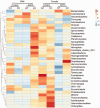Carotenoid supplementation and retinoic acid in immunoglobulin A regulation of the gut microbiota dysbiosis
- PMID: 29534601
- PMCID: PMC6582396
- DOI: 10.1177/1535370218763760
Carotenoid supplementation and retinoic acid in immunoglobulin A regulation of the gut microbiota dysbiosis
Abstract
Dysbiosis, a broad spectrum of imbalance of the gut microbiota, may progress to microbiota dysfunction. Dysbiosis is linked to some human diseases, such as inflammation-related disorders and metabolic syndromes. However, the underlying mechanisms of the pathogenesis of dysbiosis remain elusive. Recent findings suggest that the microbiome and gut immune responses, like immunoglobulin A production, play critical roles in the gut homeostasis and function, and the progression of dysbiosis. In the past two decades, much progress has been made in better understanding of production of immunoglobulin A and its association with commensal microbiota. The present minireview summarizes the recent findings in the gut microbiota dysbiosis and dysfunction of immunoglobulin A induced by the imbalance of pathogenic bacteria and commensal microbiota. We also propose the potentials of dietary carotenoids, such as β-carotene and astaxanthin, in the improvement of the gut immune system maturation and immunoglobulin A production, and the consequent promotion of the gut health. Impact statement The concept of carotenoid metabolism in the gut health has not been well established in the literature. Here, we review and discuss the roles of retinoic acid and carotenoids, including pro-vitamin A carotenoids and xanthophylls in the maturation of the gut immune system and IgA production. This is the first review article about the carotenoid supplements and the metabolites in the regulation of the gut microbiome. We hope this review would provide a new direction for the management of the gut microbiota dysbiosis by application of bioactive carotenoids and the metabolites.
Keywords: Astaxanthin; beta-carotene oxygenase 2; gut microbiome; immune system; vitamin A.
Figures


Similar articles
-
Connecting the immune system, systemic chronic inflammation and the gut microbiome: The role of sex.J Autoimmun. 2018 Aug;92:12-34. doi: 10.1016/j.jaut.2018.05.008. Epub 2018 Jun 1. J Autoimmun. 2018. PMID: 29861127 Review.
-
[Gut microbiota and immune crosstalk in metabolic disease].Biol Aujourdhui. 2017;211(1):1-18. doi: 10.1051/jbio/2017008. Epub 2017 Jul 6. Biol Aujourdhui. 2017. PMID: 28682223 Review. French.
-
Gut microbiota in autoimmunity: potential for clinical applications.Arch Pharm Res. 2016 Nov;39(11):1565-1576. doi: 10.1007/s12272-016-0796-7. Epub 2016 Jul 22. Arch Pharm Res. 2016. PMID: 27444041 Review.
-
The possible mechanisms of the human microbiome in allergic diseases.Eur Arch Otorhinolaryngol. 2017 Feb;274(2):617-626. doi: 10.1007/s00405-016-4058-6. Epub 2016 Apr 26. Eur Arch Otorhinolaryngol. 2017. PMID: 27115907 Review.
-
Integration of microbiome and epigenome to decipher the pathogenesis of autoimmune diseases.J Autoimmun. 2017 Sep;83:31-42. doi: 10.1016/j.jaut.2017.03.009. Epub 2017 Mar 23. J Autoimmun. 2017. PMID: 28342734 Review.
Cited by
-
The Molecular and Mechanistic Insights Based on Gut-Liver Axis: Nutritional Target for Non-Alcoholic Fatty Liver Disease (NAFLD) Improvement.Int J Mol Sci. 2020 Apr 26;21(9):3066. doi: 10.3390/ijms21093066. Int J Mol Sci. 2020. PMID: 32357561 Free PMC article. Review.
-
Redox signaling, mitochondrial metabolism, epigenetics and redox active phytochemicals.Free Radic Biol Med. 2022 Feb 1;179:328-336. doi: 10.1016/j.freeradbiomed.2020.12.007. Epub 2020 Dec 24. Free Radic Biol Med. 2022. PMID: 33359432 Free PMC article. Review.
-
Compositional and functional differences of the mucosal microbiota along the intestine of healthy individuals.Sci Rep. 2020 Sep 11;10(1):14977. doi: 10.1038/s41598-020-71939-2. Sci Rep. 2020. PMID: 32917913 Free PMC article. Clinical Trial.
-
Gut Microbiota and Clinical Manifestations in Thai Pediatric Patients with Attention-Deficit Hyperactivity Disorder.J Pers Med. 2024 Jul 10;14(7):739. doi: 10.3390/jpm14070739. J Pers Med. 2024. PMID: 39063993 Free PMC article.
-
Retinoic Acid, Leaky Gut, and Autoimmune Diseases.Nutrients. 2018 Aug 3;10(8):1016. doi: 10.3390/nu10081016. Nutrients. 2018. PMID: 30081517 Free PMC article. Review.
References
-
- Sekirov I, Russell SL, Antunes LCM, Finlay BB. Gut microbiota in health and disease. Physiol Rev 2010; 90:859–904 - PubMed
-
- Cox LM, Yamanishi S, Sohn J, Alekseyenko AV, Leung JM, Cho I, Kim SG, Li H, Gao Z, Mahana D, Zárate Rodriguez JG, Rogers AB, Robine N, Loke P, Blaser MJ. Altering the intestinal microbiota during a critical developmental window has lasting metabolic consequences. Cell 2014; 158:705–21 - PMC - PubMed
-
- West CE, Renz H, Jenmalm MC, Kozyrskyj AL, Allen KJ, Vuillermin P, Prescott SL; in-FLAME Microbiome Interest Group. The gut microbiota and inflammatory noncommunicable diseases: associations and potentials for gut microbiota therapies. J Allergy Clin Immunol 2015; 135:3–13 - PubMed
-
- Asahara T, Nomoto K, Shimizu K, Watanuki M, Tanaka R. Increased resistance of mice to Salmonella enterica serovar Typhimurium infection by synbiotic administration of Bifidobacteria and transgalactosylated oligosaccharides. J Applied Microbiol 2001; 91:985–96 - PubMed
Publication types
MeSH terms
Substances
LinkOut - more resources
Full Text Sources
Other Literature Sources
Medical
Miscellaneous

